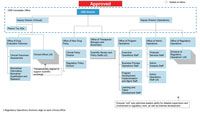FDA Readies Modernized New Drug Review Operation
FDA’s Office of New Drugs restricting aims to improve scientific exchange and information sharing among review professionals.
The Office of New Drugs (OND) in FDA’s Center for Drug Evaluation (CDER) is implementing its new structure, which features more operational support for review functions and closer alignment of review offices to therapeutic categories. The aim is to improve the consistency in review and approval decisions across OND by facilitating scientific exchange and information sharing among review professionals.
CLICK IMAGE TO ENLARGE The reorganization is designed to therapeutically align offices and divisions to support scientific exchange and improve consistency across FDA Office of New Drugs. Figure courtesy of FDA (1).

The revamped office seeks to better handle rising requests for expedited development and review programs, along with demand for special meetings to discuss R&D approaches. A related goal is to maintain CDER’s strong record for accomplishing first cycle reviews. Agency leaders anticipate a more collaborative approach among medical scientists and more integrated and cross-disciplinary operations. In the future, CDER expects that OND operations will help establish a unified post-market safety surveillance framework. Important to all these efforts is for FDA to be able to recruit and retain highly skilled technical, scientific, and professional staffers, a long-time challenge for the agency.
In addition, separate offices for new drug policy will manage the development of guidance documents and regulations, and an Office of Therapeutic Biologics and Biosimilars will handle those high-profile products. Most administrative and operational functions will be managed by new offices for program operations, administrative operations, and regulatory operations. The aim is to free medical reviewers and scientists from spending time on administrative, financial, and regulatory issues.
CLICK IMAGE TO ENLARGE Clinical office and division names. Figure courtesy of FDA (1).

The new structure features eight clinical offices with two to six divisions in each. The Office of Oncologic Diseases is the largest, while separate offices for nonprescription drugs and for specialty medicine (ophthalmology, medical imaging) are smaller. The larger offices also have their own divisions for pharmacology/toxicology. The OND review offices will be supported directly by a new Office of Drug Evaluation Sciences, which will provide support for conducting clinical outcomes assessments and for overseeing informatics and biomarker qualification.
This information was shared at a recent presentation at the FDA/CMS Summit by Khushboo Sharma, OND deputy director for operations. The presentation, CDER New Drugs Program: 2019 Update, is available at https://www.fda.gov/media/133187/download .
Figure courtesy of FDA (1).
Reference
1. K. Sharma, CDER New Drugs Program: 2019 Update, Presentation at FDA/CMS Summit, Dec. 3, 2019.
FDA Fast Tracks Johnson & Johnson’s Nipocalimab for Fetal Neonatal Alloimmune Thrombocytopenia
March 27th 2024Johnson & Johnson is moving forward with a pair of Phase III trials of nipocalimab to reduce the risk of fetal neonatal alloimmune thrombocytopenia in alloimmunized pregnant patients.